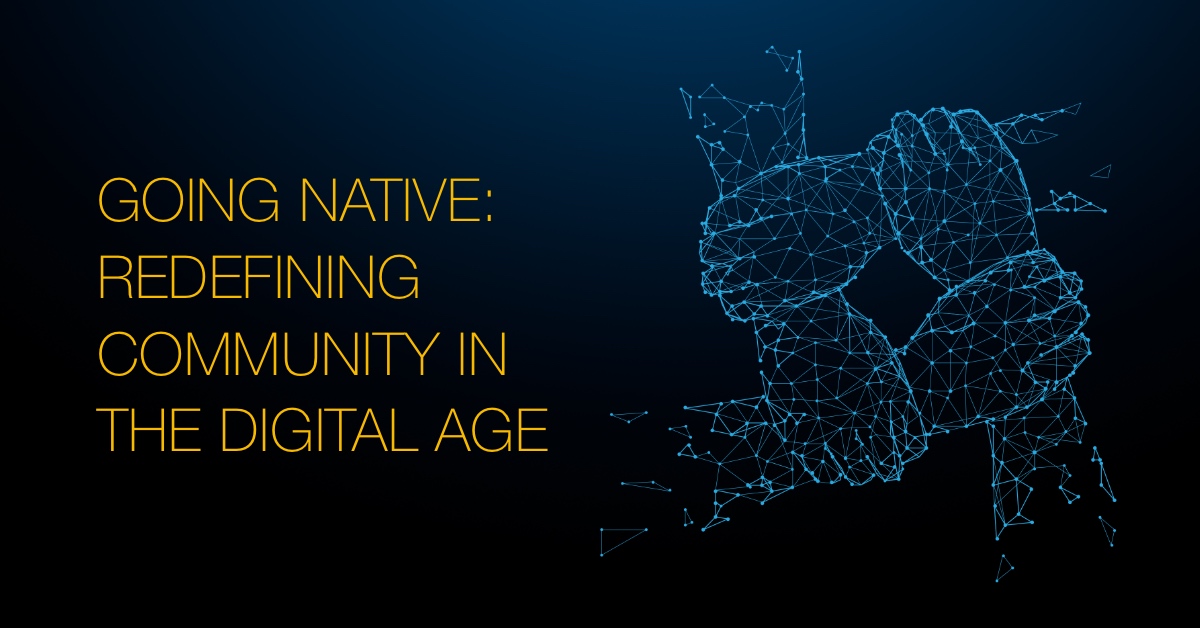
In today’s hyper-virtual world, brands are constantly seeking ways to differentiate themselves and forge deeper connections with their customers.
In the traditional advertising sense, “going native” has typically referred to native advertising— a form of paid media where the ad experience follows the natural form and function of the non-paid content with which it is placed. In most cases, the paid content matches the look and feel of the platform and borrows the credibility of the earned media it appears alongside.
Recently, however, “going native” has taken on a new definition—authentically integrating with and genuinely contributing to the communities related to your brand. These communities can be both local and virtual, spanning geographic and digital boundaries while uniting people through shared interests, values, or experiences.
The Evolving Landscape of Brand-Community Connections
Historically, “community” has been synonymous with locality – the neighborhood, town, or city where a business operates. While this remains an important aspect of the modern meaning of the term, the digital revolution has expanded the definition of community. Today, a brand’s community can encompass:
- Local geographic areas
- Online groups united by shared interests
- Customers who identify with the brand’s values and mission
- Industry partnerships and collaborations
Recognizing and engaging with these various community types can create a multi-faceted approach to standing out and building loyalty for your brand.
Strategies for Local Community Integration
1. Support Local Causes
Identify and support causes that matter to your local community. This could involve sponsoring local events, partnering with like-minded regional non-profits, or initiating community service projects. For example, a coffee shop might organize a beach clean-up or support a local arts program.
2. Collaborate with Local Businesses
Form partnerships with other local businesses to create unique offerings or experiences. This not only strengthens your local business network but also provides added value to customers. A good example of this would be a bookstore partnering with a local café to host author readings. The bookstore benefits from the exposure to new products, the café benefits from book enthusiasts purchasing refreshments and food.
3. Showcase Local Talent
Feature local artists, speakers, or influencers in your space or through your brand’s platforms. This supports the local community while adding a congenial, localized flavor to your brand identity.
4. Adapt to Local Culture
Tailor your products, services, and marketing to reflect local culture and preferences. This shows an understanding and appreciation of the community where you’re operating. That sense of locality can also be translated into digital marketing to spread that local “feel” to other geographic areas that might find its novelty compelling. Think Stabucks/Seattle, L.L. Bean/Maine, or Ben & Jerry’s/Vermont.
Cultivating a Brand Community Beyond Geography
Taking a brand’s “local-ness” outside its geographic area doesn’t always work for the broader market. That doesn’t mean the brand has to sacrifice its community, however. In many cases, a brand values, experiences, and authenticity can be just as powerful as its locality.
1. Define Your Brand’s Core Values
Clearly articulate what your brand stands for beyond its products or services. This forms the foundation of your brand community, attracting like-minded individuals who share your principles, standards, or beliefs.
2. Create Engaging Online Spaces
Find platforms where your community can interact, share experiences, and connect with your brand in meaningful ways. This could be through social media groups, forums, or even a branded app.
3. Encourage User-Generated Content
Motivate your community to create and share content related to your brand. This not only provides authentic marketing material but also strengthens your brand’s credibility in the marketplace.
4. Offer Exclusive Experiences
Hold online events, release special-edition products, or offer exclusive services for your community members. This creates a sense of belonging and rewards loyalty.
Balancing Local and Global
For brands operating at scale, it can be challenging to maintain authenticity across different local communities while nurturing a cohesive global brand community. Having a strategy or a series of strategies can help strike this important balance.
- Glocalization: The concept of “glocalization” involves adapting global strategies to fit local contexts, which is why it combines “globalization” and “localization.” In practice, this might mean creating locally relevant product variations or tailored marketing campaigns that resonate with specific, geographically based communities.
- Empower Local Teams: Give local teams the autonomy to make decisions and implement community initiatives that make sense for their specific area.
- Create Cultural Bridges: Use your global platform to facilitate a cultural exchange between different local communities, creating cohesive experiences throughout the overall brand community.
- Consistent Core, Flexible Execution: Maintain a consistent brand core (mission, vision, values, mission, and quality standards) but allow flexibility in how this core is expressed and implemented locally.
Measuring Community Impact
Ensure your community integration efforts are effective by measuring their impact. Some key performance indicators to consider include:
- Customer loyalty and retention rates
- Community engagement levels (both online and offline)
- Brand sentiment and perception changes
- Local market share and sales performance
- Employee satisfaction and retention (especially for local teams)
The Long-Term View
Building strong local or brand-based community ties is not a quick-fix marketing strategy. It requires genuine commitment, consistency, and a long-term perspective. The rewards of this dedication can be substantial: increased customer loyalty, authentic word-of-mouth marketing, and a distinctive brand identity that stands out in a crowded marketplace.
By going native and leaning into their communities, brands can create a unique value proposition that goes beyond products or services. They become an integral part of their customers’ lives and identities, fostering a level of connection and loyalty that traditional marketing strategies struggle to achieve.
Ready to redefine your brand’s community and create deeper connections with your audience? Whether you’re looking to strengthen local ties or build a global community around shared values, our team has the vision, tactics, and marketing insights you need to not merely stand out but to truly belong.
Contact us today to get started.
We are Gate. Let’s do this together.